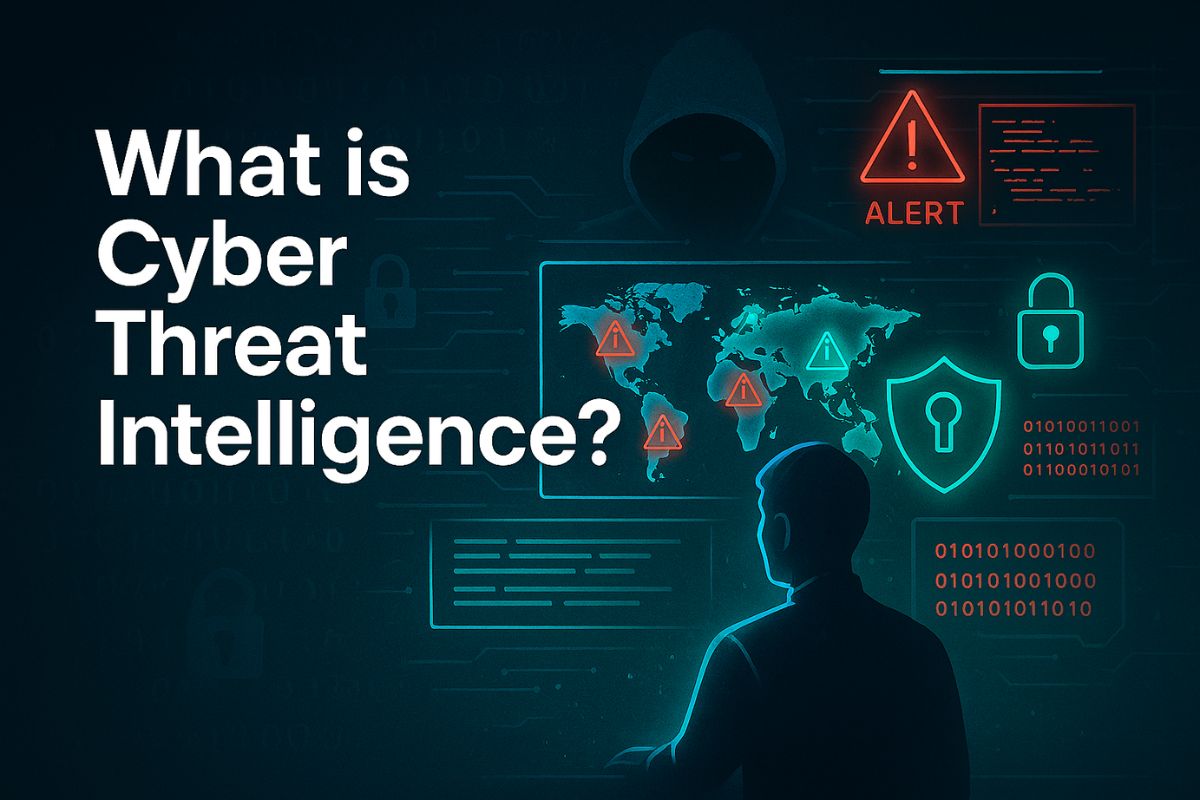Cyber Threat Intelligence (CTI) is the process of collecting, analyzing, and using data to understand threats targeting digital systems. It helps organizations detect cyberattacks, defend systems, and prevent future breaches. This guide explains the types of threat intelligence, how it works, key tools, real-world applications, and how to build a career in cybersecurity with CTI.
In today’s hyper-connected world, cyberattacks are not just possible—they’re inevitable. From data breaches to ransomware, organizations face an increasing volume and variety of threats. That’s where Cyber Threat Intelligence (CTI) comes in. CTI equips businesses and governments with actionable insights to stay a step ahead of attackers.
But what exactly is Cyber Threat Intelligence, and how can it help you build a rewarding career in cybersecurity? Let’s dive in.
What is Cyber Threat Intelligence?
Cyber Threat Intelligence is the process of collecting, analyzing, and applying information about potential or ongoing cyber threats to make informed security decisions. It’s not just about gathering raw data but transforming it into actionable intelligence that can prevent or mitigate cyber risks.
Why Is Cyber Threat Intelligence Important?
- Identifies potential threats before they cause damage
- Helps prioritize security actions
- Enhances decision-making for CISOs and security analysts
- Enables proactive defense rather than reactive response
- Supports compliance and risk management
Organizations with strong CTI capabilities can detect and stop attacks early, saving time, money, and reputational damage.
Types of Cyber Threat Intelligence
There are four main types of CTI, each serving a different purpose and audience:
| Type of Intelligence | Description | Audience | Use Case |
|---|---|---|---|
| Strategic | High-level insights on threats, trends, geopolitical risks | Executives, CISOs | Policy decisions, investments |
| Tactical | Details about adversary TTPs (Tactics, Techniques, Procedures) | SOC teams | Threat detection, defense strategy |
| Operational | Real-time info on cyber events and incidents | Incident responders | Attack monitoring and response |
| Technical | Indicators like IPs, hashes, domains | Analysts, tools | Blocking or filtering threats |
Each layer contributes to a well-rounded security posture.
How Does Cyber Threat Intelligence Work?
The CTI process typically follows this lifecycle:
1. Planning & Direction
Define what intelligence is needed. For example: Are we tracking phishing attacks or ransomware gangs?
2. Data Collection
Gather data from multiple sources:
- Logs and traffic analysis
- Threat feeds
- Dark web forums
- Open-source intelligence (OSINT)
- Social media and news
3. Processing
Clean and organize the data for analysis using automation tools and filters.
4. Analysis
Turn raw data into meaningful insights:
- Who is the threat actor?
- What is their motive?
- What techniques are being used?
5. Dissemination
Share intelligence with decision-makers, security teams, or stakeholders.
6. Feedback
Review effectiveness and refine the process.
Real-World Applications of Cyber Threat Intelligence
CTI is used across industries and sectors:
- Banking: Detect fraud, monitor phishing campaigns
- Healthcare: Protect patient data and connected medical devices
- Government: Monitor nation-state threat actors
- Retail: Prevent POS malware and credential theft
- Cloud Services: Defend against API abuse and bot attacks
Case Example:
In 2021, a healthcare provider used CTI to detect early signs of a ransomware group targeting hospitals. With proper intelligence, they blocked the attackers and secured patient records before any damage was done.
CTI Tools and Technologies
Here are some popular tools used by CTI professionals:
- MISP (Malware Information Sharing Platform) – Threat data sharing
- VirusTotal – File and URL analysis
- MITRE ATT&CK Framework – Tactics and techniques database
- Anomali ThreatStream – Threat intelligence platform
- IBM X-Force Exchange – Real-time threat sharing
- Recorded Future – Threat intelligence and risk analysis
Many CTI teams also use custom scripts, APIs, and SIEM integrations.
Expert Tips & Common Mistakes in Threat Intelligence
Expert Tips:
- Always correlate multiple sources before acting.
- Customize intelligence to your organization’s threat landscape.
- Integrate CTI into your incident response plan.
- Use the MITRE ATT&CK framework to map attacker behavior.
Common Mistakes:
- Relying too much on automated feeds
- Failing to contextualize data
- Ignoring threat intelligence feedback loops
- Not aligning CTI goals with business priorities
Resources to Learn Cyber Threat Intelligence
Getting started in CTI? These free tools and platforms can help:
- MITRE ATT&CK Navigator – https://attack.mitre.org
- AlienVault OTX – Community threat data
- CISA.gov – Government threat advisories
- SANS CTI Resources – Free whitepapers and training materials
- TryHackMe & Hack The Box – Practice labs (some free)
- YouTube Channels: Cybersecurity Meg, John Hammond, LiveOverflow
Career in Cyber Threat Intelligence: Roadmap for 2025 and Beyond
CTI is one of the fastest-growing fields in cybersecurity. Here’s how to enter and grow in this domain:
Skills Needed
- Knowledge of malware, exploits, attack vectors
- Strong research and analytical skills
- Familiarity with threat intelligence tools and platforms
- Understanding of cybersecurity frameworks (MITRE, NIST, ISO 27001)
Recommended Certifications
- CompTIA Security+
- EC-Council Certified Threat Intelligence Analyst (CTIA)
- GIAC Cyber Threat Intelligence (GCTI)
- Certified Ethical Hacker (CEH)
Career Path
- Start as a Security Analyst or SOC Analyst
- Specialize in Threat Detection/Threat Hunting
- Move into CTI roles like Threat Intel Analyst
- Grow into Threat Researcher or CTI Manager
Salary Insights (India & Global Averages)
| Role | India Salary (₹/year) | Global Salary ($/year) |
|---|---|---|
| CTI Analyst | ₹6–12 Lakhs | $70,000–110,000 |
| Threat Researcher | ₹10–18 Lakhs | $90,000–140,000 |
Conclusion
Cyber Threat Intelligence is a critical pillar of modern cybersecurity. It’s not just for large corporations—startups, governments, and even individuals benefit from CTI. If you’re passionate about cyber defense, research, and solving real-world problems, CTI offers a rewarding and impactful career path.
Stay informed, stay secure, and start building your expertise in cyber threat intelligence today!
FAQs
1. What is Cyber Threat Intelligence in simple terms?
It’s information that helps you understand, detect, and prevent cyberattacks by studying threats and attacker behavior.
2. What are the 4 types of cyber threat intelligence?
Strategic, Tactical, Operational, and Technical – each offers insights for different roles and decision levels.
3. What are examples of cyber threat intelligence?
Indicators like malicious IP addresses, phishing domains, or reports on ransomware groups.
4. How do I start a career in threat intelligence?
Begin with cybersecurity basics, gain experience as a security analyst, and earn CTI-specific certifications.
5. What’s the difference between threat hunting and threat intelligence?
Threat hunting is proactive search within networks; CTI gathers and analyzes external and internal threat data.
6. What tools are used in cyber threat intelligence?
Tools like MISP, VirusTotal, MITRE ATT&CK, IBM X-Force, and custom scripts/APIs.
7. Is CTI a good career?
Yes! It’s in high demand, pays well, and offers roles in research, defense, and leadership.


